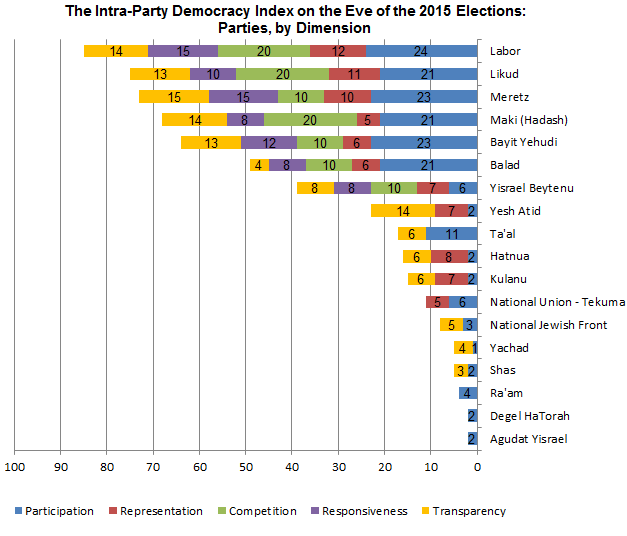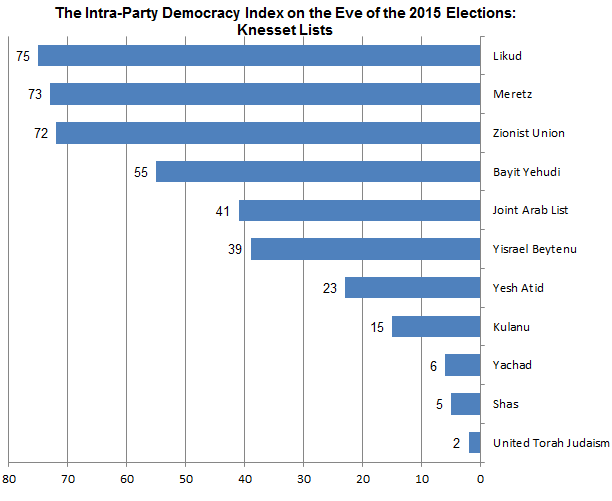The Intra-Party Democracy Index 2015

Image courtesy of Shutterstock
In the period leading up to the elections for the 20th Knesset, we set out to evaluate the internal democracy of the various parties running for election by means of the Intra-Party Democracy Index. As we see it, democracy has many facets, which parties may balance as they see fit and in accordance with their worldviews, and the existence of democracy within parties is, of course, very important. The comprehensive questionnaire used to measure intra-party democracy in Israel was first developed before the 2013 Knesset elections, based on the extensive knowledge that our research team has accumulated about political parties and intra-party democracy both in Israel and abroad.
In this evaluation, the level of intra-party democracy in Israel was examined by means of a questionnaire that was used to generate for each party a score ranging from 0, representing a total absence of internal democracy, to 100, representing the maximum amount of internal democracy. (The questionnaire can be found below in its entirety.) The dilemmas that arose during the course of the examination were discussed and settled within the broader forum of our Political Reform research group at the Israel Democracy Institute. In borderline or doubtful cases, we tended to be generous. When we could not decide between two possibilities, we gave the party a score that represents the average between the two.
The Intra-Party Democracy Index evaluates parties rather than electoral lists. The party was chosen as the unit of analysis because it is the parties, not the lists, that select their leaders and Knesset candidates, and they are the bodies that have members and extra-parliamentary institutions. In the case of multi-party lists (“joint lists”), we examined each party separately. Thus, for example, we evaluated the internal democracy of the Labor Party and of Hatnua separately, rather than evaluating the internal democracy of the joint Zionist Union list made up of these two parties. Since many of the bodies contending in the Knesset elections in Israel, especially this year, are joint lists, we have presented data for them as well, based on a weighted average of the scores of their component parties (see Figure 2).
The 2015 Index examined every party in the outgoing (19th) Knesset that is running for the 20th Knesset, whether separately or as part of a joint list. We also evaluated three new parties that were not represented in the 19th Knesset: Kulanu, Yachad, and the National Jewish Front. These parties were included because public opinion polls published in the media often predicted that these parties will pass the electoral threshold.
The full questionnaire, the findings of the evaluation, and additional background on the tools used can be found below.
The basic principle behind the questionnaire is that democracy is a multi-faceted concept that encompasses five main dimensions
- Participation
- Representation
- Competition
- Responsiveness
- Transparency
Participation and competition are fundamental aspects of any definition of democracy. Representation—i.e., the reflection of the will and opinions of the voters—is also a vital element of modern representative democracy. In order for an elected government to be democratic, there must be transparency, which makes monitoring the government's activity possible, as well as a certain amount of responsiveness, which in this context means responsiveness to the party’s representative bodies. The questionnaire thus reflects the view that intra-party democracy is important because it reinforces democracy in general, and the view that democracy has multiple dimensions that political parties balance at their discretion in accordance with their particular worldview.
These five dimensions were evaluated in this study as follows:
- Participation – The questions about participation examine the extent to which the party includes the masses in the selection of its leader and Knesset candidates and in drafting its basic policy guidelines. The questions try to strike a balance between two approaches: the first, which is dichotomous, holds that a distinction should be made between parties that are democratic and parties that are undemocratic (a view enshrined in the law books of democracies such as Germany and New Zealand), while the second approach evaluates the party’s participatory nature along a spectrum, with democracy increasing proportionally as the group that is involved in decision-making grows larger.
- Representation – The questions related to representation address, first of all, the proportion of women in the party's current Knesset faction and on its list for the next Knesset. With regard to the latter, we are interested not only in the number of women in realistic slots, but also in their relative positioning on the list. In addition, we consider whether the party's constitution or bylaws reserve positions for representatives of other sectors on its Knesset list.
- Competition – With regard to competition, the questionnaire asked whether the party held elections for the party chair and whether there have been elections for party institutions in recent years.
- Responsiveness – The questions that relate to responsiveness consider whether the elected party institutions are authorized to take part in key party decisions—e.g., the appointment of ministers, joining and leaving the government coalition, and discussions of policy—and examine whether these institutions were convened during the last two years.
- Transparency – The questions related to transparency examine how difficult or easy it is to obtain a copy of the party's constitution or bylaws—that is, the document that stipulates the party's basic rules of conduct. They also consider what information about the party is available on its website or Facebook page.
Although the main focus of the Index is Israel's political parties, it also considers the degree of internal democracy in the lists running for the 20th Knesset. These include two types of lists:
- Lists that comprise a single party: the Likud, Meretz, Yisrael Beytenu, Yesh Atid, Kulanu, and Shas. Here the score for the list is identical to the score of the party.
- Joint lists made up of two or more parties: The Zionist Union (Labor and Hatnua), Bayit Yehudi (Bayit Yehudi and the National Union–Tekuma), the Joint List of Arab parties (Ra’am, Ta'al, Balad, and Hadash), United Torah Judaism (Agudat Yisrael and Degel Hatorah), and Yachad (Yachad and the National Jewish Front).
The score for each joint list is the average of the scores of its component parties, weighted by the number of representatives that each party has in realistic spots on the joint list (For a discussion of how "realistic spots" were calculated, see the notes on questions 2.1 and 2.2.) For example, the Zionist Union has 21 realistic spots. Because 17 of the first 21 candidates on the Zionist Union's joint list are from Labor and four are from Hatnua, the weighted average for the Zionist Union's list employs a coefficient of 17 for the Labor Party’s score and 4 for Hatnua’s. Similarly, Bayit Yehudi list is considered to have 12 realistic spots, with a ratio of 10 for the Bayit Yehudi party and two for the National Union–Tekuma. The Joint List of Arab parties has 11 realistic spots, with coefficients of 4 for Hadash, 3 for Ra’am, 3 for Balad, and one for Ta’al. United Torah Judaism has seven realistic spots, with a ratio of four for Agudat Yisrael and three for Degel Hatorah. Yachad has four realistic slots, with a ratio of three for the Yachad party and one for the National Jewish Front.
Participation (30%)
1.1 Who chooses the party leader? (5%)
- A group of elected representatives (central committee, convention, council) or all members of the party (5 points)
- A small group (e.g. an appointed committee) or a single leader (0 points)
1.2 Who chooses the party leader? (5%)
- A single leader (0 points)
- A small group (1 point)
- Elected representatives (3 points)
- All members of the party (4 points)
- All citizens of voting age (5 points)
1.3 Who selects the candidates for inclusion in the party’s Knesset list? (5%)
- A group of elected representatives (central committee, convention, council)
- all members of the party (5 points)
- A small inner circle of the party elite or an elected leader (0 points)
1.4 Who of the following selects the party’s Knesset list? (5%)
- A single leader (0 points)
- A small group (1 point)
- Elected representatives (3 points)
- All members of the party (4 points)
- All citizens of voting age (5 points)
1.5 Who of the following participated in writing or approving the party platform? (5%)
- The party doesn’t have a platform (0 points)
- A single leader (1 point)
- A small group (2 points)
- Elected representatives (3 points)
- All members of the party (4 points)
- All citizens of voting age (5 points)
1.6 Who of the following took part in ideological debates conducted by the party in the last four years? (5%)
- The party doesn’t conduct ideological debates (0 points)
- Elected representatives (3 points)
- All members of the party (4 points)
- All citizens of voting age (5 points)
Representation (20%)
Note that the results for questions 2.1–2.3 will be multiplied by 2/3.
2.1 What percentage of realistic spots on the party list are held by women? (5%)
- More than 45% (5 points)
- 35%–44% (4 points)
- 25%–34% (3 points)
- 15%–24% (2 points)
- 5%–14% (1 point)
- Less than 5% (0 points)
2.2 What is the value of the weighted Women Ranking Index (i.e., not just the number of women in realistic slots, but also their placement on the list)? (5%)
- More than 0.45 (5 points)
- 0.35–0.44 (4 points)
- 0.25–0.34 (3 points)
- 0.15–0.24 (2 points)
- 0.05–0.14 (1 point)
- Less than 0.05 (0 points)
2.3 What percentage of the party's Knesset members are women? (5%)
- More than 45% (5 points)
- 35%–44% (4 points)
- 25%–34% (3 points)
- 15%–24% (2 points)
- 5%–14% (1 point)
- Less than 5% (0 points)
2.4 Does the party employ special mechanisms (e.g., reserved spots, districts) in order to guarantee representation of the following groups on its Knesset list? (10%)
- Ethnic minorities (Arabs) or religious minorities (Muslims, Christians, Druze) (2 points)
- Recent immigrants (2 points)
- Senior citizens (2 points)
- Young adults (2 points)
- Residents of the geographical periphery (2 points)
Competition (20%)
3.1 Has there been a contest (with two or more candidates) for the position of party leader since the last general elections? (10%)
- Yes (10 points)
- No (0 points)
3.2 Have there been elections for the party's institutions during the last four years? (10%)
- Yes (10 points)
- No (0 points)
Responsiveness (15%)
4.1 Do the party’s representative institutions… (10%)
- Take part in selecting the party’s ministers in the government? (yes = 4 points; no = 0 points)
- Approve whether the party joins or leaves the coalition? (yes = 3 points; no = 0 points)
- Conduct debates about policy matters? (yes = 3 points; no = 0 points)
- Does the party have a representative institution and has it met at least once in the last two years? (yes = 5 points; no = 0 points)
Transparency (15%)
5.1 How easy is it to obtain a copy of the party constitution or bylaws? (5%)
- The up-to-date text of the constitution or bylaws is available on the party website or was sent to the researchers after their first request. (5 points)
- The text of the constitution or bylaws was obtained only after a number of requests. (3 points)
- The text of the constitution or bylaws was not obtained even after repeated requests. (0 points)
5.2 Are the following available on the party’s website and/or Facebook page? (10%)
(For the overall weighting, the number will be divided by 2 and rounded to no more than 10 points)
- Bylaws (3 points)
- Platform or document of principles (3 points)
- Information about the party’s history (1 point)
- Biographies of the party’s Knesset members or candidates (1 point)
- A biography of the party leader (1 point)
- A list of party officials and their contact information (1 point)
- Future party events (1 point)
- Documentation of party events (1 point)
- Articles or transcripts of speeches by party members (1 point)
- Does the website/Facebook page use languages other than Hebrew (or another primary language)? One other language (1 point); Two or more additional languages (2 points)
- Information about contributors (1 point)
- Forums and multimedia (video clips, links to YouTube or Facebook, etc.) (1 point)
- Possibility of sending an e-mail/contacting the party through its website (1 point)
- Chat forums or other interactive options on the website (1 point)
- News and updates (1 point)
- Information about local party branches (1 point)
- General: The data are based on the bylaws or constitution of the parties and on information provided by their authorized officials, their websites, and the media. The last date of sampling of the data, including the content available on the websites of the parties, was February 5, 2015. When there was a clear and irrefutable contradiction between the party's bylaws or constitution and what actually takes place in reality, we relied on the latter.
- Question 1.1: The terms “elected representatives” (in question 1) and “representative institutions” (in question 4) refer to bodies in which at least half of the members are elected by the members of the party or the public at large.
- Questions 1.3–1.4: Reserving up to 20% of the realistic spots on the list for candidates who are chosen by the party leader did not affect the score for these questions.
- Question 1.5: If the party has a platform or a document presenting basic principles, but it is not known who wrote it or ratified it, we considered the document to have been written by a “small group.” In the case of a joint list, the platform of the list (if it exists) was considered to be the platform of each of the parties in the list.
- Questions 2.1–2.3: The score for questions 2.1–2.3 was multiplied by two-thirds so that the maximum possible score is 10. Question 2.3 was omitted for new parties that were not represented in the 19th Knesset. In cases in which that question was dropped, the value of questions 2.1 and 2.3 was 7.5% each.
- Questions 2.1–2.2: The number of realistic spots for a veteran party is the number of Knesset seats it won in 2013. For a new party, the number of realistic spots was based on the average number of seats predicted in public opinion polls during the last three days before it submitted its list of candidates to the Central Elections Committee. If the polls predicted fewer than 4 seats for a new party, it was considered to have 4 realistic spots.
- Question 2.2: The Women Ranking Index takes account both of the proportion of women in realistic spots and their position on the party's list. [For further information, see Gideon Rahat, Reuven Y. Hazan, and Richard S. Katz, “Democracy and Political Parties: On the Uneasy Relationships between Participation, Competition, and Representation,” Party Politics 14 (6) (2008): 679.]
- Question 2.3: A party’s data were examined as of the inauguration of the 19th Knesset; any changes that may have taken place since that time were ignored.
- Question 2.4(a): This question was not considered in the case of parties in which a majority of candidates belong to ethnic or religious minorities. Such parties were awarded 2.5 points each for the answers to questions 2.4(b) through 2.4(e).
Click to enlarge figure.

Participation: The Index examined who takes part in making important decisions, such as choosing the party's leader and Knesset candidates.
Representation: The Index examined the extent to which women and other groups (minorities, residents of the periphery, new immigrants, young adults, senior citizens) are included on the party’s Knesset slate.
Competition: The Index considered whether the party has held elections for its leader since the last Knesset elections and whether there were elections for the party institutions during the last four years.
Responsiveness: The Index examined whether the party has elected representative bodies that are active and whether those bodies influence key party decisions and policy.
Transparency: The Index examined whether it is possible to obtain information about the party, such as its bylaws or information about its Knesset candidates, and the ease with which such information can be obtained.

